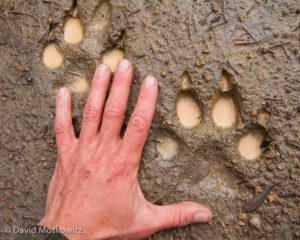 Perhaps the prototype of all the reading humans do is tracking.
Perhaps the prototype of all the reading humans do is tracking.
Tracking an animal is opening the door to the life of that animal. It is an educational process, like learning how to read. In fact, it is learning how to read. Following an animal’s trail may bring you closer to the animal physically, but more important, it brings you closer to it in perception.… The more intimate we become with other lives, the more aware we are of how those lives connect with and affect our own. There may be only a few obvious connections at first – two animals in the same woods, hearing the same sounds, smelling the same smells – but as we track the animal farther, we find that its trail is our own trail. As it moves, it affects its surroundings. What changes the animal changes its environment, and thus changes us. There is no separation; its fate is our fate. We are tracking ourselves in a sense.
— Paul Rezendes (1999, 15)
You can read the signs. You’ve been on this road before.
— Laurie Anderson, United States
Was it ystwith wyst or Lukan Yokan or where the hand of man has never set foot?
— The Restored Finnegans Wake, 159
Nature’s own guidance system must encompass yours and mine. We assume that there is such a universal guidance system because we read the signs of regularities in nature. Science is the attempt to formulate the rules governing the processes we observe. As long as these formulae serve to guide our actions appropriately (that is, to the extent that they enable us to take a next step on the path), we continue to use them. Yet in our moments of waking we know there is always more to discover. Carlos Castaneda (or his ‘Toltec’ mentors) encapsulated this in the set of precepts called ‘the rule of stalkers,’ which is necessary for the ‘warrior’s’ life but also ‘applies to everyone’:
The first precept of the rule is that everything that surrounds us is an unfathomable mystery.
The second precept of the rule is that we must try to unravel these mysteries, but without ever hoping to accomplish this.
The third, that a warrior, aware of the unfathomable mystery that surrounds him, and aware of his duty to try to unravel it, takes his rightful place among mysteries and regards himself as one. Consequently, for a warrior there is no end to the mystery of being, whether being means being a pebble, or an ant, or oneself. That is a warrior’s humbleness.
— Castaneda (1981, 281)
A similar spirit pervades the four bodhisattva vows of Mahayana Buddhism, though here compassion comes to the foreground:
Sentient beings are innumerable; I vow to save them.
Desires are inexhaustible; I vow to end them.
The Dharma teachings are boundless; I vow to master them.
The Buddha Way is unsurpassable; I vow to attain it.— Cook (1978, 32)
What is called arousing the thought of enlightenment is the uttering of the vow to emancipate all living beings even while you yourself are not yet emancipated. When one arouses this thought, no matter how humble in appearance one is, one then becomes the guide of all beings.
— Dogen (Cook 1978, 43)